History of the Los Angeles Theatre
Dawn of the Movie Palace
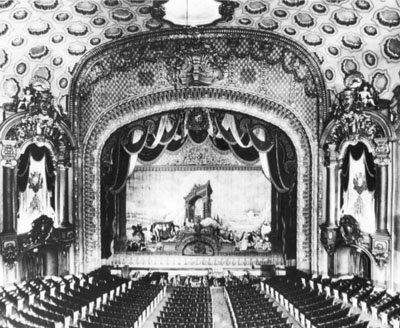
It is doubtful that the Los Angeles Theatre would have become a reality in all its elegance, flamboyance and excess without the strong personalities of William Fox, S. Charles Lee and H.L. Gumbiner. All three were individualists who were not afraid to take on the establishment and try the untried.
William Fox had by this time built one of Hollywood’s largest film studios, a chain of theatres that spanned the country, owned the patents to the new sound-on-film process and had even acquired control of Loew’s Corp., the parent company of MGM Studios. He had also, with the help of his wife, built some of the largest and most elaborate movie palaces in the country, including 5,000 seat theatres in Detroit, St. Louis, Atlanta and San Francisco. It is very possible that he had acquired the site of the Los Angeles for another of these movie palaces.
Unfortunately, by 1930 Fox was under siege from all sides. He had suffered a debilitating auto accident, the phone company was trying to wrest from his control the patents for film sound, his acquisition of MGM was being challenged on antitrust grounds, and he was even losing control of his own studio and theatre chain. Under these circumstances it is understandable that he would allow H. L. Gumbiner to develop the theatre site.
H. L. Gumbiner was an independent exhibitor from Chicago who had moved to Los Angeles in the early 1920′s. He acquired two theatres on Broadway, the Cameo and the Garrick. Gumbiner’s philosophy was that he could challenge the theatre chains operated by the big studios if his own theatres were so enticing that the major studios would feel obliged to give him their pictures to satisfy public demand. Gumbiner’s first test of this idea was the new Tower Theatre he planned for the site of the Garrick at 8th and Broadway. On this small 50′ by 150′ lot Gumbiner wanted to build a 1,000 seat movie palace as well as several stores.
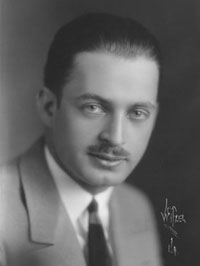
Most architects said it was impossible, but S. Charles Lee, who had never designed a theatre on his own, convinced Gumbiner to hire him. In order to meet Gumbiner and approach him about the Tower Theatre commission, Lee had a friend arrange a cocktail party (at Lee’s expense) to which Gumbiner would- be invited. Lee then promised that Gumbiner would not have to pay for his services if he could not produce an acceptable design and get all the necessary zoning variances from the city. Lee succeeded and the Tower became an instant money-maker.
Designing the Los Angeles
It was not long before Gumbiner began planning for an even larger and more elaborate theatre. He again chose S. Charles Lee, who by this time had parlayed his success with the Tower Theatre into a whole host of building commissions in Southern California. Lee had originally trained with the firm of Rapp and Rapp in Chicago, and gained valuable experience in helping design their atmospheric movie palaces.
When Lee moved to Los Angeles to strike out on his own at the age of 21, whatever he may have lacked in experience he more than made up for in self-confidence and drive. This flair for self-promotion served Lee well in his career, and he took full advantage of Gumbiner’s desire that the Los Angeles Theatre outshine the movie palaces of the major studios by designing a theatre that would remain his most famous and remarkable through a career that lasted another twenty years.
The design of the Los Angeles Theatre bears a striking resemblance to the legendary 5,000 seat Fox Theatre in San Francisco, built by Fox in 1926. Fox may very well have shared the plans of the San Francisco Fox with Gumbiner and Lee. In any case, Lee gave the theatre his own unique imprint, with a host of special touches and technical innovations.
No expense was spared in the decor of the Los Angeles, which included crystal chandeliers, marble, gold leaf, silk damask wall coverings, walnut paneling and an extraordinary fountain of marble and crystal in the upper lobby. The main lobby of the theatre, with its soaring 50 foot ceiling, chandeliers and grand staircase, was a welcome departure from earlier cramped theatre lobbies. It was Lee’s plan that the main lobby and basement lounges together could accommodate a group of 2,000 people waiting for the next showing.
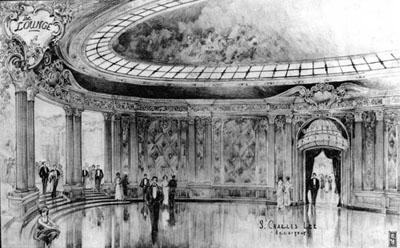
All draperies and carpets were custom-made for the theatre by the B. F. Shearer Company in shades of royal blue, deep red and gold. The main stage drape is an incredible three-dimensional scene rendered in silk, depicting events in the life of Louis XIV. It is said to be one of the two most expensive drapes ever made for a movie palace. Figures depicted on the curtain include Louis XIV, his wife, his mistress, and the French army and navy. The center of the curtain is dominated by a large triumphal arch surrounded by clouds and the rays of the sun, done in metallic gold and silver thread.
Lee designed the theatre with many special features for the comfort and delight of patrons, including a children’s playroom; a refreshment room with a soda fountain; two ‘crying rooms’ on the mezzanine level: where mothers and their infants could watch the show in a glassed-in booth with its own speaker, air conditioning controls and a rest room; a large cosmetics room next to the ladies toilet with individual vanities and a three-sided full length mirror; a three-chair shoeshine stand in the men’s room; eight aisles on the main floor so that there were no more than six seats in each row; and separate loge sections on the main floor separated and elevated above the other seats.
State of the Art Technology
Besides the incredible decor, the Los Angeles was also the most technically advanced theatre of its day. The lighting was controlled by a special Westinghouse dimming system as flexible as any available today. Each circuit of lights could be preset to five different levels of illumination and .then all circuits could be activated at once to their own particular level. A large wheel on the dimming board allowed cross-fading between one preset level and another. The preset board was disconnected in the 1940′s, but the dimmers themselves are still in use today.
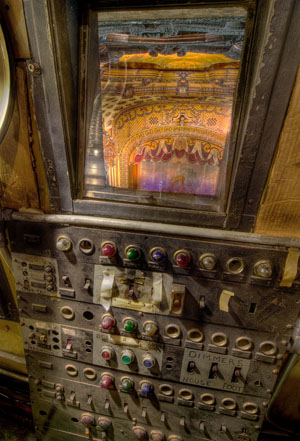
The sound system was also the most modern available. Not only was the film sound state-of-the art, the theatre also had an extensive public address system with banks of amplifiers in the projection booth powering speakers and microphones throughout the theatre. Announcements could be made to patrons in the various lobbies and lounges, and the film sound could be piped to the waiting areas and to the outside lobby to entice patrons inside. Large speakers were also installed above the proscenium and in the organ chambers for live shows, and the auditorium was one of the first to be ‘tuned’ for amplified sound. In contrast, most movies palaces of the twenties had to undergo architectural and decorative changes when amplified sound came into use.
The projection equipment was ultra-modern and the large booth was able to hold extra projectors in case of a breakdown, as well as two large spotlights and a Brenograph the machine that projected song slides and announcements on the screen. The movie screen measured almost 60 feet wide by 30 feet high, one of the largest in the city. It was built to accommodate the early Magnascope wide-screen process, which unfortunately never really caught on. A unique periscope system designed by an engineer from the California Institute of Technology used a prism and a series of large mirrors to project the film image from the booth down to the basement lounge.
The use of neon lighting was another early innovation. In 1931 neon lighting was only a few years old and had not yet been used extensively in theatres. Lee used neon not only on the exterior vertical marquee, but also as aisle lighting in the main auditorium.
Blue neon tubes were imbedded under strips of 2 inch thick glass on each side of the main aisles, providing a gentle glow in the darkened theatre. Again Lee was well ahead of his time – similar strip lighting is now used in the aisles of most modern multiplexes.
Although built primarily as a movie house, the Los Angeles had a full stage, orchestra pit and dressing rooms, allowing the presentation of elaborate live prologues before the film. The live show could even continue after the last film, as the basement lounge was designed with a parquet wooden floor under the carpet for dancing to the accompaniment of the theatre’s orchestra.
Opening Night
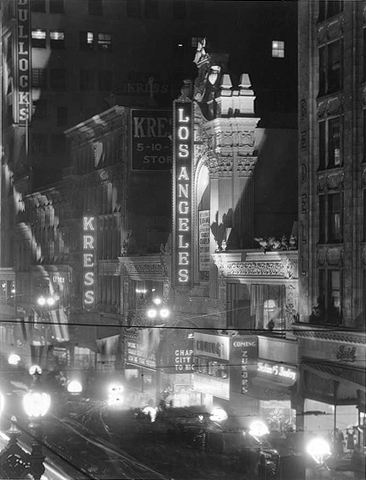
The theatre was built in less than six months. In August of 1930 there was only an excavated hole in the ground, and in January of 1931 the theatre had its grand opening. Lee speeded construction by having the plaster ornamentation fabricated off-site and then brought to the building and fit together like a jigsaw puzzle. Most other theatres of the day had their decorative plaster molded and finished in place, with artisans working on scaffolding.
As opening day approached the Depression deepened and Gumbiner began to run out of money. Like all theatres, his Tower and Cameo theatres were not generating the income they had in the twenties. Gumbiner had already contracted with Charlie Chaplin to open his new theatre with the premiere of Chaplin’s “City Lights”. It is said that Chaplin invested his own money to finish the theatre in time for his film’s premiere. Some extra features were eliminated in the name of saving money including a music room off the basement lounge, an infirmary, and two other periscope projection systems for the music room and the outside lobby.
Opening night was a glittering affair, with Chaplin in attendance, scores of dignitaries, and even Albert Einstein. Outside, a crowd estimated at over 25,000 thronged Broadway to get a glimpse of the celebrities. The Depression brought a tinge of irony to this celebration of sumptuous luxury, as part of the crowd outside waited in a bread line across the street.
Gumbiner was justifiably proud of his new theatre, and unintentionally angered Chaplin when he interrupted the showing of “City Lights’” to point out some of the beautiful features of the auditorium. The two men had very different emotions that night as Chaplin waited anxiously to gauge the audience’s reaction to his new silent film with recorded sound accompaniment, and Gumbiner reveled in the audience’s awe and delight in his new movie palace.
1930s and Beyond
Gumbiner’s joy would prove to be short-lived, as the theatre’s financial condition quickly worsened, compounded by his inability to book first-run films from the major studios. The theatre’s creditors, including architect Lee, forced Gumbiner’s company into bankruptcy only three months after the theatre opened. The Los Angeles operated under court-supervised receivership for eight months until it finally closed in December of 1931. It was later re-opened by William Fox, who had gained control of the theatre occupying his land through bankruptcy court. Although Gumbiner hung onto the Cameo and Tower theatres for many years, he would never again control the theatre that was his life’s dream.
Fox operated the Los Angeles as a second-run house until 1939 when the theatre was leased to Metropolitan Theatres which operated several other Broadway theatres, including the Orpheum, Rialto, President (later the Globe), Palace and the Tower. Metropolitan was controlled by Fox West Coast Theatre, the largest chain on the West Coast, and was therefore able to get a good supply of new films. The Los Angeles continued as a second-run house until 1944 when the huge supply of new films motivated Fox West Coast to switch the Los Angeles to first run showings of the best new MGM films.
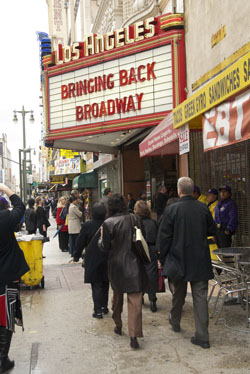
This period was the real heyday of the Los Angeles as war-weary Angelenos packed the theatre from 8 AM until 6 AM every day, often catching a film in the early hours before dawn after working swing shift at a war plant.. Pictures such as “The Harvey Girls”, “Ziegfeld Follies” and “Meet Me in St. Louis” ran for several weeks each, often with grosses exceeding $30,000 per week. Promotional activity was a crucial factor in the success of the theatre during this period. For a typical picture, this might include extensively decorating the exterior of the theatre, arranging display windows at local department stores tied into the coming movie, broadcasting interviews from the theatre and arranging contests and give-aways to draw crowds to the opening week.
This success continued after the war, until the U.S. Justice department’s consent decree in the late 1940′s forced the major studios to give up their theatre chains. Metropolitan Theatres gave up the Los Angeles to Fox West Coast, which itself was being divested from Twentieth Century Fox Studios. Fox West Coast operated the Los Angeles from 1949 until 1962, when television, the growth of the suburbs and changing demographics led the Major chains to exit downtown. Metropolitan Theatres was the only chain still operating on Broadway, and they took back the Los Angles that year, operating it until 1994, when the theatre closed as a first-run house. During those years of the 1960′s, 1970′s and 1980′s, the theatre tried many formats, from first-run action films to adult films to Mexican films to English films with Spanish subtitles. Finally, in the 1990′s the audience had dwindled to the point where Broadway could not support so many large movie palaces competing for the same small audience.
During the 1980′s, the ownership of the theatre changed for only the second time in its history, going from the family of William Fox to Delson Investment Group. Delson Investment has continued to maintain and upgrade the theatre. It has become a unique location for filming and video. It has been used in several feature films, including New York, New York, Jim Carrey's Man on the Moon, Chaplin, Charlie's Angels II, and Cinderella Man. As Downtown finds a renewal of energy and life, driven by the recent influx of new residents inhabiting the old buildings and lofts of the downtown historic district, the Los Angeles Theatre looks forward to opening its doors to a new century of theatre goers.



